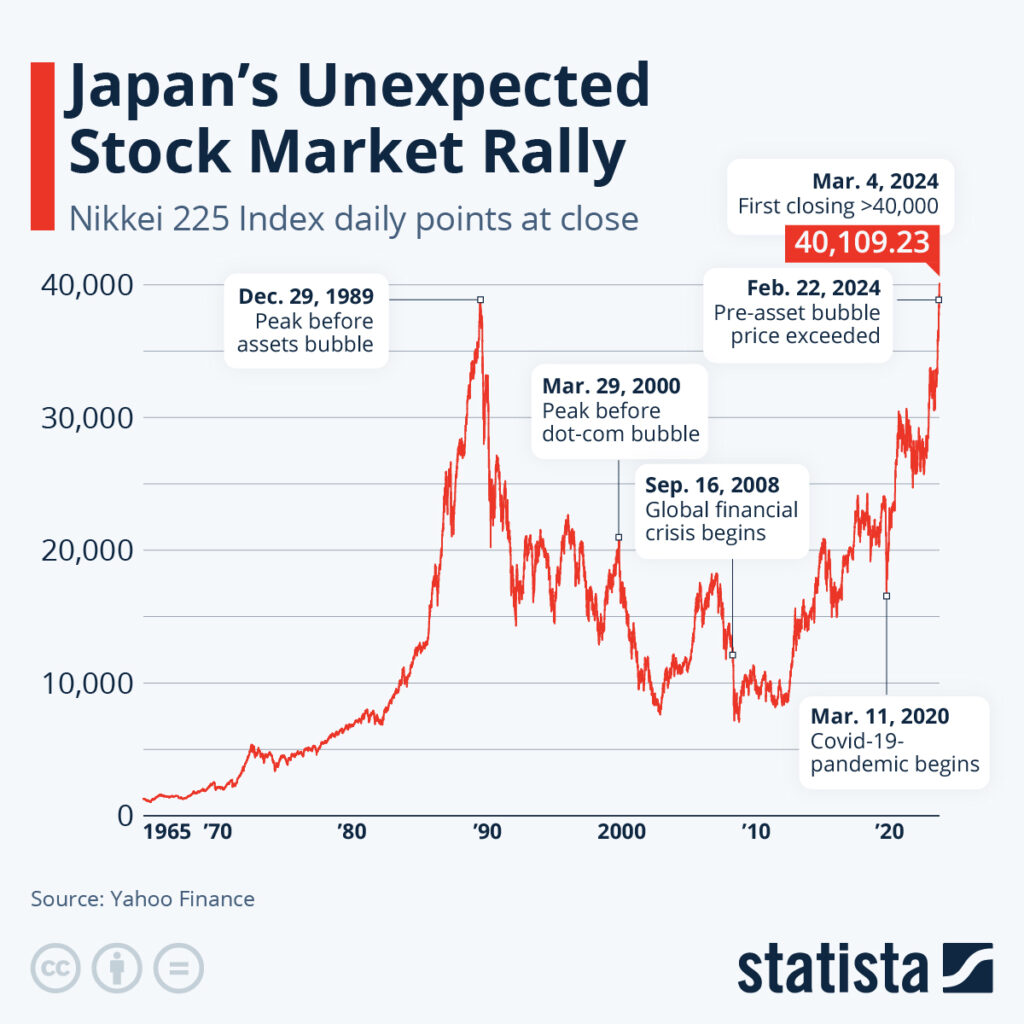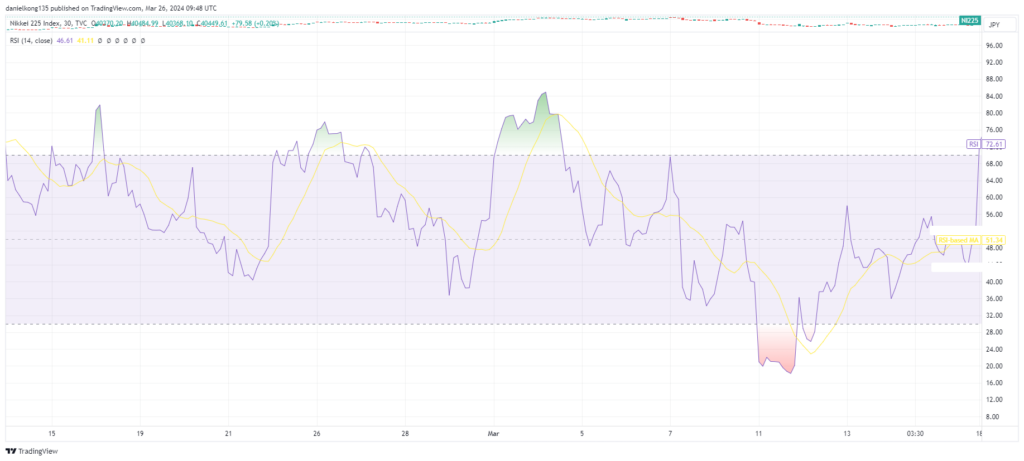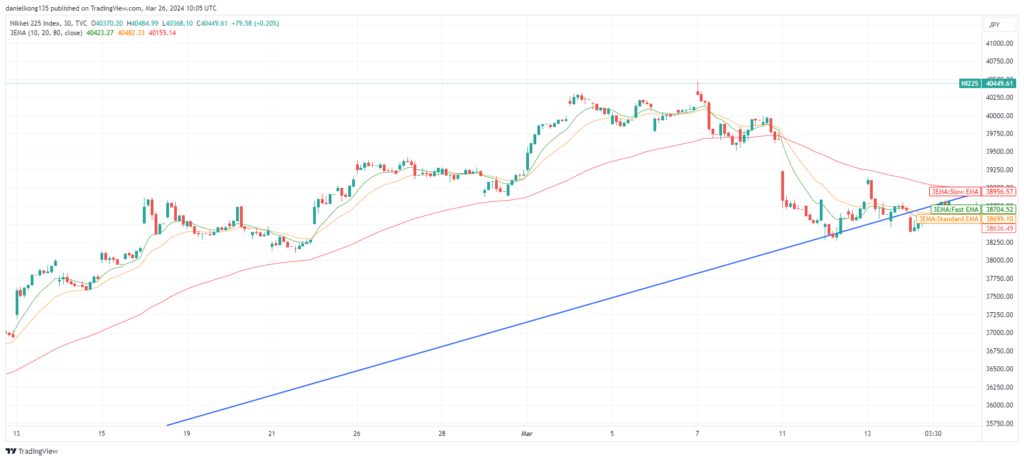The Nikkei 225 Index is a stock market index used in Japan. It tracks the top performing companies that are publicly traded on the Tokyo Stock Exchange, with constituents drawn from an array of different sectors.
Due to its wide coverage and long-established history, the Nikkei 225 Index (also known as “the Nikkei”) is considered to be a major benchmark of the Japanese stock market.
After decades of middling performance, the Nikkei recently hit new highs after 34 years; the index broke the 39,000-point level on 22 February 2024, and then hit a new record of 40,109 on 4 March 2024 [1,2].
Explore the dynamics of the Japanese market through insights into trading the Nikkei 225 with CFDs in this article, including key factors to consider, effective trading strategies, and approaches to risk management approach.
Key Points
- The Nikkei 225 Index, tracking the 225 largest companies on the Tokyo Stock Exchange, serves as a major benchmark for the Japanese stock market and offers a diversified portfolio across 35 sectors.
- After a historical performance, including a “Lost Decade,” the Nikkei hit a record high of 40,109 in March 2024, fuelled by interest in AI and significant investments from global investors.
- Trading the Nikkei 225 with CFDs allows for speculation on price movements without owning the underlying assets, offering strategies for different trading durations and highlighting the importance of risk management.
What is the Nikkei 225?
The Nikkei 225 is a widely acknowledged benchmark of the Japanese stock market. It tracks the 225 largest domestic companies listed on the Tokyo Stock Exchange, covering a total of 35 different sectors.
These sectors range from construction, manufacturing and materials, to pharmaceutical, oil, aerospace, real estate, retail, trading and services, making for a very well-rounded coverage of the Japanese economy. Another unique feature is that only homegrown Japanese companies are included – this is distinct from other popular stock market indices, in which foreign companies listed in the local stock exchange may also be included.
The Nikkei has been calculated daily by the Nihon Keizai Shimbun newspaper since 1950. It is weighted by price; this means every stock in the index is weighted by its current share price, and stocks with higher prices have more influence on the index than those with lower prices.
Composition and trading hours
At the time of writing, the top 10 constituents of the Nikkei are as follows:
| Company | Weight (%) |
| Tokyo Electron Ltd | 7.50 |
| Advantest Corporation | 3.81 |
| Softbank Group Corp | 3.75 |
| Shin-Etsu Chemical Co Ltd | 2.94 |
| Daikin Industries Ltd | 2.29 |
| Fanuc Corporation | 2.06 |
| TDK Corporation | 2.00 |
| Recruit Holdings Co Ltd | 1.77 |
| Kyocera Corporation | 1.63 |
| Chugai Pharmaceutical Co Ltd | 1.59 |
Trading hours of the Nikkei 225 Index [4]
The Nikkei follows the trading hours of the Tokyo Stock Exchange.
- Mondays to Fridays
- 9am to 11.30am
- 12.30pm to 3pm
The exchange is closed on Saturdays, Sundays, National holidays, from 1 January to 3 January, and on 31 December.
Why trade the Nikkei 225 Index?
The Nikkei 225 Index offers investors a high degree of diversification, as it draws from multiple different sectors. Thus, there is relatively lower volatility, as advances in winning sectors can help make up for losses in others.
Being a price-weighted index with constituents from 35 different sectors, the Nikkei is also more evenly distributed than indices weighted according to market capitalisation. For instance, the top 10 holdings make up just 29.34% of the index by weight, limiting the individual impact of constituents.
In addition, the Nikkei is a good representation of the overall Japanese economy, lending itself well to a country or region-based portfolio composition.
Historical trends of the Nikkei 225 Index

After World War 2, the Japanese economy experienced rapid and sustained growth due to technological change, accumulation of capital, increased quantity and quality of labour, and increased international trade.
The event, dubbed the Japanese Economic Miracle, went on for decades, propelling Japan to its position as the third largest economy in the world.
However, this meteoric rise soon came to an abrupt halt. Between 1991 and 2001, the Japanese economy experienced a severe slowdown, triggered when the Bank of Japan Japan hiked interest rates in an attempt to cool down the red-hot real estate market.
This period came to be known as Japan’s Lost Decade and is reflected on the Nikkei which established a record high in December 1989 of 38,915.87 points [5]. Conditions were further worsened with the dot.com crash of the 2000s, which caused the Nikkei to fall to a new low of 7,607 in April 2003 [6].
The Japanese economy’s recovery was interrupted by the Global Finance Crisis, which caused the Nikkei to once more crash down to post-bubble lows around the 10,000-points mark.
A turnaround would come, starting in 2013, and the Nikkei has been charting an impressive upward trend since then.
Nikkei Record high in 2024
After 34 years, the Nikkei recently hit a new record high in March 2024. The first breakthrough came on 22 February, when the index broke 39,000 points, surpassing the previous all-time high. Weeks later, the Nikkei surges to an even higher record of 40,109 on 4 March 2024 [7].
The reason for the surge is attributed to the increased interest in AI and its potential future developments; the Nikkei’s rally was led by advances in two semiconductor stocks – Tokyo Electron and Advantest, up 3.15% and 2.65% respectively [8].
This prompted an influx of global investors lured by corporate governance reforms, a weak yen and a tax-deferred investment program aimed at small investors, the Nippon Individual Savings Account, or NISA.
According to the Tokyo Stock Exchange, Japanese stocks experienced an inflow of 2.07 trillion yen from international investors, an almost four-fold increase from a year earlier [9].
How to trade the Nikkei 225 Index with CFD
Investors looking to capture upsides from the Japanese stock market may consider trading the Nikkei using Vantage CFDs (Contracts-for-Difference).
CFDs allow speculation of the price movement of the index without direct ownership of fund units or stocks of the companies represented in the Nikkei 225 Index.
Here’s how it works: You open a trade by choosing whether the index will go up or down. If the price goes with your position, you make a profit. If it goes against your position, you will incur a loss.,
At the close of the contract, the difference in the price of the index is settled directly in your account.
One advantage of CFDs is that you can make trades on leverage, which will increase your gains if the trade goes in your favour. However, using leverage will also increase your losses if the trade goes against you. Hence, leverage should be used with caution.
Also, CFDs allow you to take both long and short positions. This means that you don’t have to wait for the index to rise in order to make a profit. You can also take a short position to profit when the index falls.
Lastly, CFDs have a comparatively lower barrier to entry. You can start trading the Nikkei with lesser capital, compared to buying shares of an index fund that tracks the Nikkei.
Analysing the Nikkei 225 market
Fundamental analysis
As a national stock market benchmark, analysing the Nikkei 225 involves building an understanding and awareness of the Japanese economy, as well as developments that may impact the stock market.
Traders should pay attention to the following.
Economic data
Economic data such as GDP, interest rates and inflation levels are important signallers of the Japanese economy, and can impact the Nikkei 225 Index. As of the time of writing, the Bank of Japan had raised its interest rate for the first time in nearly two decades to around 0% – 0.1% [10]. Changes in the interest rate could cause a temporary slowdown in the current rally seen in the Japanese market.
Corporate earnings
Keep track of upcoming earnings reports from the leading companies listed in the Nikkei. Results that fall under expectations will likely cause share prices to fall, which could bring the index down. As the Nikkei is price weighted, pay attention to the shares with the highest cost prices; these have the biggest influence on the index.
Industry trends
The Nikkei 225 Index is relatively more equally distributed, so industry trends may have limited impact. Nonetheless, given the presence of closely related sectors in the index, it may be prudent to keep track of forming industry trends and developments, and the potential opportunities they represent.
Technical analysis
The Nikkei 225 Index can also be analysed using technical analysis, although this would require a price chart, charting tools, and the knowledge on how to use and interpret them.
The following indicators may be useful.
Relative Strength Index (RSI)

The screenshot above shows the RSI for the Nikkei 225 Index for the past one month. The RSI is an indicator that shows when the index is overbought (above 70) or oversold (below 30).
When paired with other indicators, the RSI can help you establish suitable points for buying or selling the index. Taken by itself, the RSI can also indicate market sentiment.
Starting from the left of the chart, we can count SEVEN occasions when the RSI went over 70, indicating clear strong investor interest. As we continue down the chart, we see that market sentiment has calmed down somewhat, with the index trading well within normal ranges.
Line of Support and 3 EMA

In the screenshot above, the blue line charts a Line of Support, while the green, yellow and red lines are the Triple Exponential Moving Averages (3 EMA). These are, of course, drawn on the price chart of the Nikkei 225 Index, covering the most recent 3 weeks or so.
You may find it useful to refer to our other guides for detailed explanations on these indicators, but for the purpose of analysing the Nikkei, we can see that the index is starting to break through the Line of Support, which some analysts may interpret as a possible sign of a forthcoming retracement..
This can be further confirmed by studying the 3 EMA. Over the next few days, if the green line moves upwards and crosses under the yellow line, this may mean that there is still some steam left in the rally. However, if the green line fails to break through the yellow line, the rally is likely to soon come to a stop.
Bear in mind that technical indicators are merely tools that help us form an informed opinion on the state of the market. No indicator is 100% accurate, nor is there any that can predict which way the index will go.
Trading strategies for the Nikkei 225 index
The dynamic nature of the Nikkei lends itself well to a variety of trading strategies, whether short, medium or long term. Here are some strategies to consider.
Short-term trading strategies
Day trading
Day trading the Nikkei is a strategy that focuses on short-term trades that mostly last a day, or less than a day. Day traders do not keep trades open overnight, so as to avoid risks from unexpected announcements.
The idea is to achieve as many winning trades as possible during each day of trading, maximising returns over multiple wins. Discipline is required, as is the ability to make fast decisions to capitalise on opportunities when they emerge, and to limit losses when a particular trade goes against you.
News trading
News trading may be less intensive than day trading, as it does not require quick, short-term trades. Instead, you should look out for relevant news and announcements or other pertinent developments that could have an impact on the Nikkei, and set up corresponding trades to capitalise on the resulting price movement.
This method isn’t foolproof (no trading strategy is), as there may be instances where news reports fail to have the expected impact, or conversely, seemingly minor developments may elicit an exaggerated response from investors.
Mid-term trading strategies
Swing trading
Swing trading is a popular trading strategy that aims to capture potential returns when a swing in the price of the Nikkei occurs.
A swing is when the price changes direction from up to down, or down to up. Swing traders try to identify moments when swings occur, and choose appropriate trades to profit from them.
Because swings can be found throughout the trading day, swing trades can be short-lived – opened and closed in a few hours or day.
On the other hand, price swings may also last a while, and swing traders would need to keep their trades open to capture as much profit as possible until the swing runs its course. This may mean holding trades overnight, which comes with the risk of volatility from unexpected or sudden events.
A typical swing trade lasts anywhere from two days to several weeks, depending on the volatility of the market, and how big of a swing the trader wants to capture. As such, swing trading is a suitable strategy for those who prefer medium-term strategies.
Long-term trading strategies
The Nikkei 225 is also well-suited to long-term trading strategies, including up to and beyond several months or years.
The case for a simple buy-and-hold strategy is particularly intriguing, given that the index has how well the index has performed in the past one year. This is especially so with the March crossing of the 40,000-point mark, which may signal the end of Japan’s prolonged economic doldrums, and the long-awaited start of a new bull run.
Investors with a strong conviction in the long-term trend of the Nikkei should note that they cannot own the index directly. Instead, they will need to purchase units in an index fund that tracks the performance of the Nikkei – some popular examples include:
- iShares Core Nikkei 225 ETF
- iFree ETF Nikkei225
- Maxis Nikkei225 ETF
- Nomura Nikkei 225 Exchange Traded Fund ETF
When choosing an ETF to invest in the Nikkei, pay attention to the expense ratio, which is the fee charged by the fund managers. Generally, expense ratios for such ETFs are low, as the funds are set up to mimic the Nikkei automatically.
Nevertheless, you should look to invest in the ETF that has the lowest expense ratio, as such fees can eat into your returns, especially over the long term.
Risk management strategies when trading Nikkei 225 Index
While the Nikkei is a highly popular and important market index, proper risk management should still be practised during trading. Remember the following tips and recommendations.
Set proper trade sizes
The size of each trade should be limited to under 2% of your total capital [11]. This will prevent your account from taking substantial losses, or even being wiped out in a prolonged series of bad trades.
Make use of stop-loss and take-profit
When a trade goes against you, you may be tempted to hold on in the hopes that the trade will reverse course and turn your losses into profits (or at least breakeven). This is often inadvisable, as it is impossible to predict when the index will bounce back, or to what extent.
Hence, be sure to set a stop-loss point to cut your losses and preserve your remaining capital for the next trade. One suitable point to set a stop-loss is when the index falls below a key support level.
Meanwhile, a take-profit point prevents loss of profit from greed. A winning trade may tempt you to keep the trade open in the hopes of capturing more profit. But in doing so, you’ll risk having the price move against you and wipe out your gains.
For instance, watch out for when the index approaches a key resistance level after a large move upwards. This may be a good time to sell and take profit, before consolidation takes place.
Use leverage with caution
Leverage can be a powerful ally, but it could also be your worst enemy. Remember that while leverage magnifies your gains from a winning trade, any losses will also be increased by the same degree. This can result in losses that exceed your capital, putting your account in the negative.
Have a trading plan in place
Above all, understand that trading requires a highly disciplined approach. Traders that enter trades with no proper logic or reasoning, and do not have clear guidelines on how to handle market changes, are likely setting themselves up for failure.
Instead, formulate a detailed trading plan that spells out your goals and objectives, strategies you will use, appetite for risk, and your maximum budget available for trading each week or month.
These factors will form the basis of your trading plan, which you should always strive to stick to. This will help you develop the discipline and habits required for long term success.
Conclusion: Trade Nikkei 225 Index with Vantage
Trade the Nikkei with Vantage CFDs to potentially benefit from the Japanese economy without direct ownership of underlying fund units or company shares. Enjoy features such as tight spreads and low cost – starting from $0 per trade.
Control risk with tools such as negative balance protection, price alerts and stop losses, recognizing that losses could also occur. Stay informed with real time new alerts on our mobile app and trading platform, enabling quick reactions to market developments and trading flexibility on the go. Sign up for a live account and experience the Vantage advantage today.
References
- “Nikkei parties like it’s 1989; hits record high – Reuters” https://www.reuters.com/markets/asia/nikkei-parties-like-its-1989-scales-record-high-2024-02-22/ Accessed 21 March 2024
- “Bullish Nikkei 225 index closes at record high 40,109 – The Asahi Shimbun” https://www.asahi.com/ajw/articles/15187243 Accessed 21 March 2024
- “Nikkei 225 – MarketScreener” https://www.marketscreener.com/quote/index/NIKKEI-225-4987/components/ Accessed 21 March 2024
- “Trading Rules of Domestic Stocks – JPX” https://www.jpx.co.jp/english/equities/trading/domestic/01.html Accessed 22 March 2024
- “Nikkei Index Sets First Record High Since 1989 – Nippon.com” https://www.nippon.com/en/japan-data/h01927/ Accessed 22 March 2024
- “Japan ends year on a high – CNN” https://edition.cnn.com/2003/BUSINESS/12/29/asiastocks.tuesclose/ Accessed 21 March 2024
- “Nikkei 225 tops 40,000 for first time – NHK World Japan” https://www3.nhk.or.jp/nhkworld/en/news/20240304_28/ Accessed 21 March 2024
- “Japan’s Nikkei breaches 40,000 level for first time on tech boost – The Economic Times” https://economictimes.indiatimes.com/markets/stocks/news/japans-nikkei-breaches-40000-level-for-first-time-on-tech-boost/articleshow/108189696.cms?from=mdr Accessed 22 March 2024
- “Foreign buys of Japan stocks hit 7th-highest value since 1982 in January – Nikkei Asia” https://asia.nikkei.com/Business/Markets/Foreign-buys-of-Japan-stocks-hit-7th-highest-value-since-1982-in-January Accessed 21 March 2024
- “Japan Interest Rate – Trading Economics” https://tradingeconomics.com/japan/interest-rate Accessed 21 March 2024
- “2% Rule: Definition as Investing Strategy, With Examples – Investopedia” https://www.investopedia.com/terms/t/two-percent-rule.asp Accessed 21 March 2024




